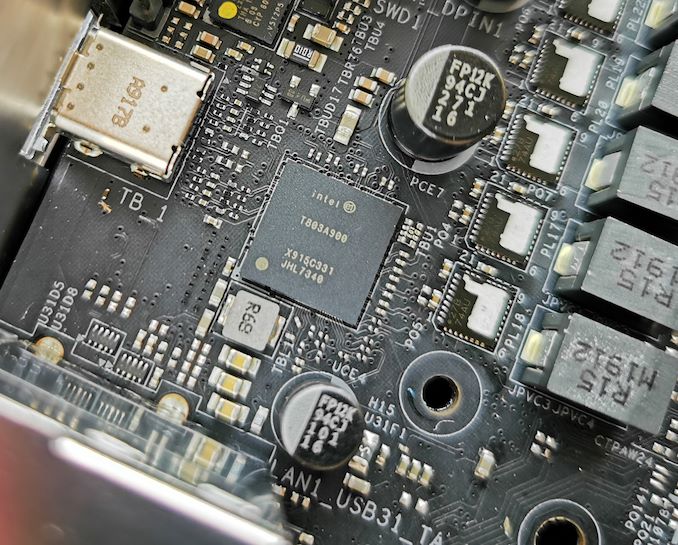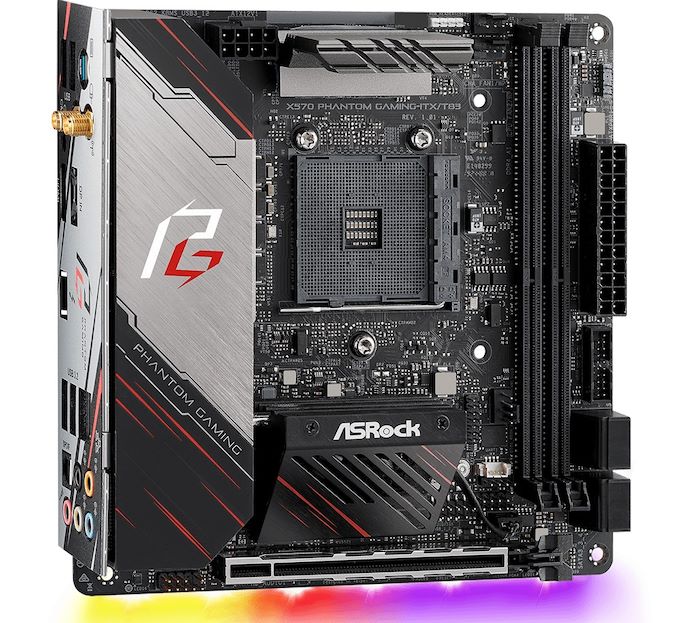AMD + ITX + TB3? It's the ASRock X570 Phantom Gaming-ITX/TB3 Motherboard Review
by Gavin Bonshor on October 9, 2019 12:00 PM ESTASRock X570 Phantom Gaming-ITX/TB3 Conclusion
The ASRock X570 Phantom Gaming-ITX/TB3 ($240) is one of just three mini-ITX motherboards across three different vendors on the X570 chipset. This makes it an interesting space for the vendors to get everything right as the GIGABYTE X570 I Aorus Pro WIFI ($220) and the ASUS ROG Strix X570-I Gaming ($299) are the only other two models to truly occupy this ITX space. Each has its own take on mini-ITX on X570, but the standout board on paper is almost certainly the ASRock X570 Phantom Gaming-ITX/TB3; not just based on features, but the combination of features for the price.
One of the primary features which sets the Phantom Gaming-ITX/TB3 apart from the competition is the inclusion of an Intel JHL7340 Thunderbolt 3 controller. This adds a single Type-C port on the rear panel, as well as a DisplayPort 1.4 input for users looking to drive multiple displays with resolutions of up to 4K from a discrete graphics card. On top of this is a Realtek ALC1220 HD audio codec which powers both the rear panel audio connections and the front panel audio header.
Also on the rear panel is an HDMI 2.0 video output for users of Ryzen's APUs, two antenna ports for the Intel AX200 802.11ax wireless interface, and just four USB 3.1 G1 Type-A ports. Aside from the four Type-A on the rear panel, users can expand this through the USB 3.1 G1 and USB 2.0 headers with each offering support up to two ports. For reference, the GIGABYTE X570 I Aorus Pro WIFI has five Type-A ports on the rear panel and doesn't include Thunderbolt 3 connectivity.
The GIGABYTE X570 I Aorus Pro WIFI is slightly cheaper but trades the Thunderbolt 3 for an extra M.2 slot. The main caveat of the single PCIe 4.0 x4 M.2 slot on the ASRock board is that it's located on the rear of the PCB meaning users with NVMe drives could experience some throttling under heavy loads, and the best approach to take would be to ensure adequate passive cooling for the rear of the board. Users looking to use SATA will need to use the four SATA ports available in the bottom right-hand corner of the board. With the board being mini-ITX, there's no scope to add additional M.2 slots with add-on cards like there is on ATX models. Memory support is very good with support for up to DDR4-4533 and up to 64 GB of total capacity. AMD Ryzen 3000's sweet spot for memory is DDR4-3600, so maximizing performance isn't too much of a concern with the insanely fast DDR4 kits, but ASRock does give users the option if they wish to do so.

ASRock loves adding Thunderbolt 3 capability
The performance of the ASRock X570 Phantom Gaming-ITX/TB3 is highly competitive and shines in the two areas most ASRock models we've seen of late generally do; POST time and out of the box DPC latency performance. Overall performance in our computational benchmarks was average with some good showing in benchmarks such as 3DPM but lower than usual results in Blender. Our overclocking performance testing proved that the ASRock X570 Phantom Gaming-ITX/TB3 is efficient in terms of load CPU VCore with the default LLC profile with good VDroop control and under volting where it's needed. Even though there are no overclocking presets for the CPU, the Eco mode which stated 45 W as opposed to our Ryzen 7 3700X's 65 W TDP proved very fruitful for users looking to build a slightly lower-powered small form factor system; Eco mode performance was on par with 3.8 GHz performance in our manual testing.
Turn the Lights Off, Carry Me Home

ASRock Phantom Gaming X570-ITX/TB3
For users looking to build a small form factor system using Ryzen 3000 with Thunderbolt 3 devices, the ASRock X570 Phantom Gaming-ITX/TB3 is a no brainer at just $240.The ASRock X570 Phantom Gaming-ITX/TB3 in our opinion continues ASRock's recent trend of providing formidable mini-ITX solutions. We can't wait to fit one with a 16-core Ryzen 9 3950X, which is expected to hit shelves in November.











64 Comments
View All Comments
DanaGoyette - Thursday, October 10, 2019 - link
I'll bet nobody buys micro ATX partly because all the micro ATX boards are crippled in things such as audio codec (enjoy your ALC887), Ethernet (yay Realtek), or in Asrock's case, poor VRM efficiency.Nobody buys because there are no good boards, no good boards because nobody buys.
TheinsanegamerN - Thursday, October 10, 2019 - link
I remembre when there were tons of micro ATX chioces, the gigabyte snimer M.3, the asus boards, ece.Even intel only has two good micro ATX boards, both from asus. Nothing from gigabyte, nothing good from MSI or ASrock. At least the TUF micro has a good audio chip (Realtek ALC S1200A) and intel NIC.
Jasmij - Wednesday, October 9, 2019 - link
Throughout the review I see much talk about Thunderbolt but benchmarks are missing.This board failed certification by Intel.
https://thunderbolttechnology.net/products?tid=15&...
Can we get some Thunderbolt compatablity and speed tests?
DCide - Wednesday, October 9, 2019 - link
I would like to see tests too, but I don’t see how this motherboard “failed certification” simply by being absent from a list where the newest motherboard I could find was the 2018 Z390 Designare.jeremyshaw - Wednesday, October 9, 2019 - link
Also, didn't Intel already open standard Thunderbolt? They may not be in charge of certification anymore.DCide - Wednesday, October 9, 2019 - link
Yes, they did - right about the time the list appears to have stopped growing!jab701 - Thursday, October 10, 2019 - link
FYI, they are still in charge of certification.If you want to use the thunderbolt logo on your device you *have* to pass certification.
I read that even though USB 4 (or is it USB4) will integrate thunderbolt, if you wish to use the thunderbolt logo it will *still* have to pass intels certification process. This sounds a bit dodgey but if you think about it, I would rather be sure my graphics card enclosure is going to work properly.
Given The number of USB device out there which *apparently* conform to the USB standard but do not interoperate properly, I would say that USB certification might not be stringent enough.
(I say this as an Electronic Engineer who has found numerous issues getting kit to work together properly in systems I design and use as part of my job).
Cooe - Thursday, December 19, 2019 - link
This is so freaking false I don't even know where to begin. To legally put the official Thunderbolt logo & branding on ANY for sale product, it MUST pass Intel's certification process. This is a certified board, regardless of what you've read. In fact, it's the major price tag that comes with this certification process for all non-Intel hardware that has kept Thunderbolt off AMD (in an officially supported capacity) until this point (Intel waives the certification fee on products w/ Intel CPU's).This is made explicitly clear with the fact that unofficially Thunderbolt 3 works just fine (w/ the Titan Ridge PCIe card) on most all other AM4 as well as X399 boards (with the small exception of device hot swap support not working), but w/o said pricey certification this isn't an "officially" supported setup.
andychow - Wednesday, October 9, 2019 - link
"a DisplayPort 1.4 input for users looking to drive multiple displays with resolutions of up to 4K from a discrete graphics card". How???The DP goes from your discrete graphic card into the motherboard. Then what?
jeremyshaw - Wednesday, October 9, 2019 - link
It is for TB3.